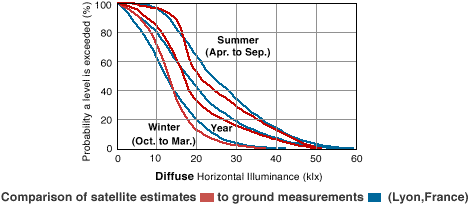The horizontal illuminances Horizontal Illuminances are computed from horizontal irradiances using the luminous efficacy model from Olseth (Olseth, 1989). It has been selected for its capability to adapt to changes in aerosol and water vapor content of the atmosphere and to changes in the depth of the cloud cover. It has been shown to lead to better results than other models using data from Gävle (Norway), Geneva (Switzerland), Lyon (France) and Lisboa (Portugal) (Olseth, 1997). The luminous efficacy model is based on the CIE values of the spectral luminous efficiency in photopic vision and spectral irradiances obtained by an interpolation between transmittance models for respectively cloudless sky (Bird, 1986) and unbroken cloud cover (Stephens, 1984). This interpolation decomposes the diffuse irradiance into "blue sky", "dark cloud" and "bright cloud" irradiances. For partly cloudy cases, the model was slightly tuned to hourly global illuminance and irradiance from Bergen (Norway). The parameterized version of the model requires as input the solar elevation, the day of the year and the clearness index applied to the direct and diffuse components of solar radiation. In the case of the direct solar radiation, the model has been slightly modified to account for variations in column amount of water vapor, under the assumption that water vapor extinction takes place solely at non-visible wavelengths. In the case of the diffuse solar radiation, the model has been tuned to data from Albany (New York State, USA) by multiplying the difference between the efficacy of "dark cloud" irradiance and the efficacy of the extraterrestrial normal irradiance by a factor 0.7. As for the computation of irradiances, two different directions were taken to evaluate the precision of the method. The first one consisted in comparing every half hour the satellite estimates to the ground measurements. The second one consisted in comparing end user products generated from the satellite estimates to those generated from the ground measurements. The results are presented below for the global and the diffuse horizontal illuminances in Lyon, France.
The tilted illuminances Illuminances on tilted surfaces are computed from irradiances on tilted surfaces using the diffuse and direct luminous efficacies of the horizontal irradiance. The luminous efficacies are computed using the method presented above. The figures below present a comparison betwen the satellite estimates and the ground measurements, on a half hour basis, for the global illuminances on a vertical plane facing: North, East, South and West, in Lyon, France. Absolute deviations between measured and modelled values are within -5 and +5 klx. More information on the performance of the model in 4 IDMP sites is given by Olseth (Olseth, 1997).
|







